These two footpockets are currently high in demand and considered by many to be two of the best currently on the market. Having now used both of them I felt I'd share my experience...the reviews are based on my own experience as a Freedive Instructor/judge (Full time:) ) where I use equipment on a daily basis for everything from my own deep dives, instructing, freedive photography and videography and working as a safety diver in our competitions. Hope it helps give some informative information to assist other divers in deciding...:)
Salvimar 4One Footpocket Review
By Jacques de Vos | Published Jan 17/2012
This review is aimed at competitive and recreational Freedivers (deep diving).
Some time ago I did some research to find the best footpockets for a pair of newly acquired carbon blades and although there are quite a few options available on the market, my search was finally narrowed down to two brands. Presently considered amongst many to be the best on the market, the two options were the Salvimar 4One footpocket and the Pathos Fireblade footpocket – which I discussed in a previous review.
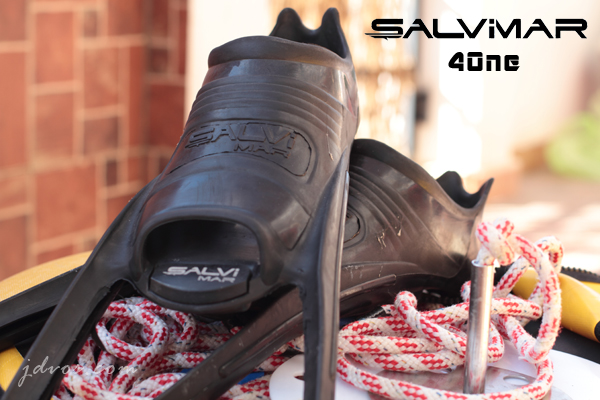
As a full time Freedive Instructor and Freedive Photographer and Videographer I needed something which would be good as an all round footpocket even when doing deeper dives myself. I managed to get some very honest answers from a well known online dive store (from whom I eventually ordered the 4One’s) as they stocked both pairs at roughly the same price. Here is the original email concerning the Salvi 4One’s (the sender is Bulgarian, hence the poor English):
“Hey, Jacques…
The Salvi is a heavier but much more comfortable footpocket. It’s perfect for student dives at 30m as well as depths and deeper. It’s as soft as the fireblade if not softer. The angle is more or less the same and the pocket could be fitted to any blade.
Note that the groove on the ribs is wider (like on OMER). When mounting you glue a separate thin rib on the blade. After that you fit the Salvi with just few drops of glue. When you change the blade you can remove the footpocket without destroying it, which makes it reusable! And this is very important I believe!
my recommendation as of this moment is – Salvi, because:
- it’s good for dives to 30m.
- it’s more comfortable
- it’s reusable!
Regards”
As my blades were already drilled and I never used to be a fan of gluing blades into footpockets (that has changed), I settled on the slightly heavier Salvimar footpocket…
The Review:
I would never have guessed it but mounting the blades turned out to be a nightmare…the rails on my blades were not big enough (although they were the standard rubber profile attached to most blades) to fill the MASSIVE rail cavity in the ribs of the footpocket. The guys at the Dive store were not kidding, the groove was more like a canyon! Definitely much wider than the OMER footpockets and the ‘entry’ to the cavity measures 5mm with the actual rail section inside being almost double.
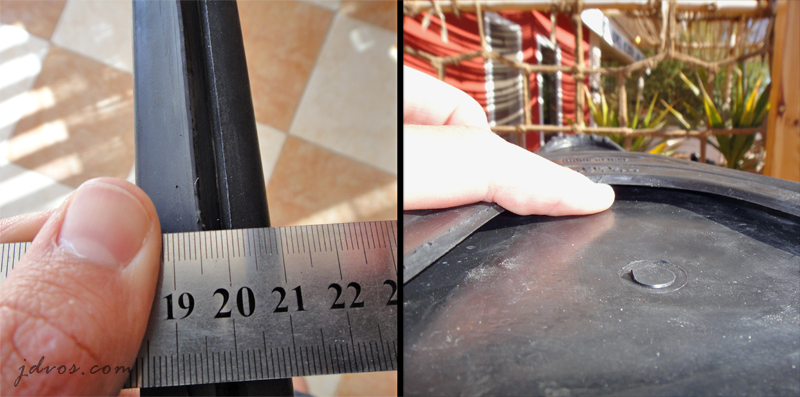
Note the massive gap for the rails. The entry point for the footpocket is so wide that it leads to potential ‘play’ whilst diving…
Having mounted a few blades before using Sikaflex (if memory serves me right 291 – marine grade ) as it is easy to disassemble if needed, I opted to ‘glue’ the rails into the footpocket to make it fit snugly. The part of the footpocket where the ‘tongue’ of the blade enters the footpocket also needed A LOT of padding as the groove was as wide as the rib groove and the footpocket would have way to much ‘play’ while diving which would surely result in a break.
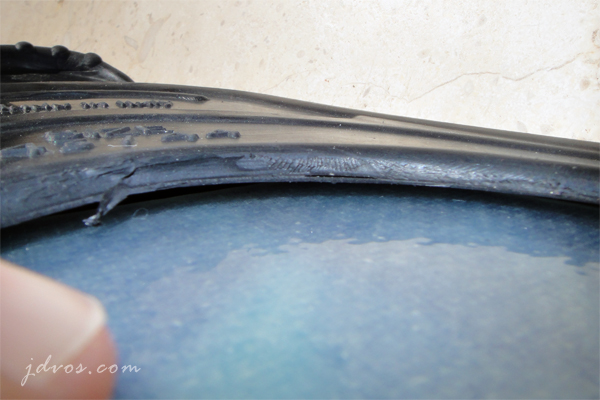
Quite a large amount of play is visible at the point where the tongue of a blade (blue) is inserted into the footpocket.
Sikaflex is nasty, nasty stuff…no matter how cleanly you try to work you usually end up with hands so black it looks like you strangled a roughneck on an oil rig…only difference is you can wash off oil, Sikaflex on the other hand can take days to remove (quick hint: forget soap…just wait for it to dry and spend your time picking it off). The curing time is also something ridiculous so I usually leave the glued and very well taped blades to stand for at least 3 days before even considering using them.

Sikaflex 291…messy
A very important note: If your blades are not secured in the footpocket, meaning the tongue of the blade which slides into the footpocket has too much room for movement (or ‘play’) especially at the point where they flex, the blade could potentially snap due to the stress caused by lack of support beyond the point of attachment.
SO
Finally I get to start using the blades in their newly fitted Salvimar 4One footpockets and here are the results:
At first I was very impressed with how comfortable they felt especially considering they were not the lightest footpockets I’ve ever worn. I tend to dive without socks and was very happy at how comfortably the footpockets fit. The only thing which initially caused me some discomfort was the two little ‘horns’ on the back of the pocket. I never got completely used to them but it might be due to the shape of my feet as I’m sure many other divers don’t feel them at all.
Pros:
- Quite light (although nowhere near as light as the Pathos Fireblade)
- Comfortable fit and quite soft
- Lots of reinforcement across the bridge of the foot to optimise power transfer into the blades
- VERY well finished (they look beautiful straight out the box with no apparent (keyword!) defects or blemishes
- Nice angle (as stated in the email) which is ideal for deeper dives – nice angle during freefall section of a deep dive.
Cons:
- The rib grooves are far too wide…actually ridiculously wide.
- ‘Horns’ on the heel seems to serve to practical function and causes discomfort when diving
- Worked well when not wearing socks (apart from the fact mentioned beforehand)
- The Ribs are too thick – This results in a reduction of the intended blade flex characteristics and performance as the thick ribs acts like struts and reduces the ability of the blade to flex the way it they were intended to by the manufacturer. With soft blades they essentially cause them to feel stiffer…(see the review for the Pathos footpockets for more information on this)
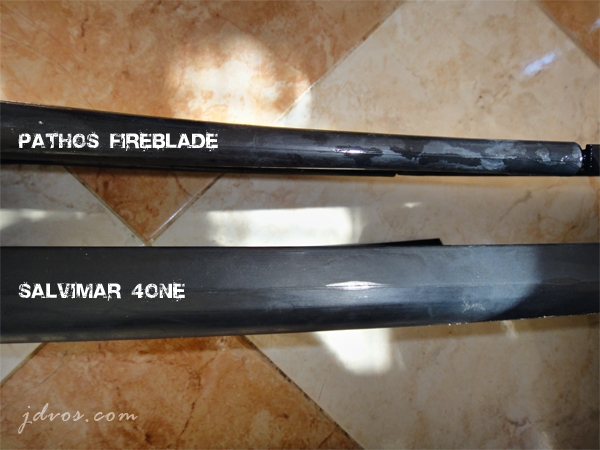 The
The
VERY thick ribs of the Salvimar 4One compared to Pathos Fireblade. The wide ribs reduces performance of the blade dramatically and is enough reason for me not to invest in another pair of 4One’s.
And then…
After a month of use they started to become undone…literally!
Quite soon after I started using them I started feeling something irritating my foot and sticking my finger inside, all I could feel was a bump and some sort of ‘grassy substance’.
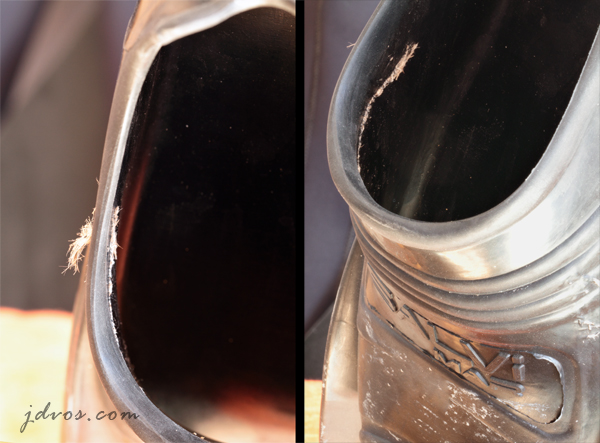
The threadlike substance which at first appeared to be a small defect until eventually it got worse…
Soon I started noticing something resembling a thread starting to appear on the outside of the footpocket (where no friction occurs) and with every dive it became more and more visible. I realised that the thread I was seeing on the outside was somehow connected to what it was I was feeling inside the footpocket.
For some or other reason the rubber compound of these footpockets contain some sort of threadlike substance – perhaps to increase strength?…who knows, but there seems to be no logical planning into how it is distributed. My first impression was that it was a piece of string that fell into the rubber mould (its that bad!) leading to a defect footpocket, until we started inspecting a new pair and found the same thing right underneath the surface of the rubber. The only problem is that there seems to be no logical assembly to these threads and this was later confirmed by comparing other pairs of brand new Salvi 4One’s, where when viewed closely a line shaped protrusion is clearly visible in certain areas of the footpocket (in particular around the bridge of the foot) and as mentioned before they never seem to be in the same place.
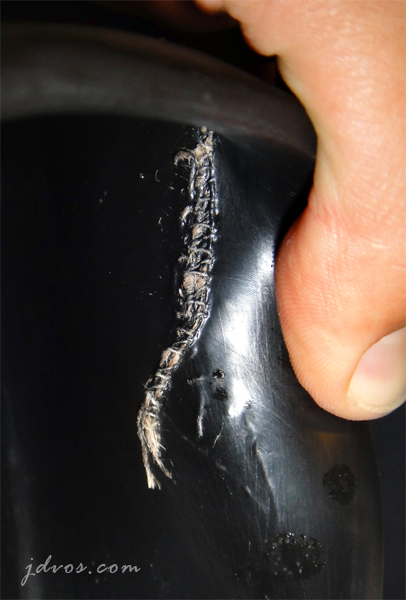
The original image I sent to the dealer to bring their attention to the problem…
I was very disappointed in the short time it took for the footpockets to start disintegrating to the point where it was too uncomfortable to dive without socks and it was clear that the largest of the threads would eventually lead to a tear right through the side of the footpocket. The first thing I did was to contact the seller for an exchange which ultimately led to my first pair of Pathos Fireblade Footpockets which was brought to me from Greece.
Searching the internet I have found very few reviews on the 4One’s as most people tend to discuss them quite vaguely (talking about comfort and weight only). I hope this review will help future buyers to inspect their 4One’s closely before paying the ridiculously high prices they sell for or if you have already invested in a pair, to at least to check them closely for any defects. The more people bring this major defect to Salvimar’s attention the more likely they are to improve the quality of their product.
Final Thought
I would be very reluctant to recommend Salvimar’s 4One to anyone wanting to use them for deep diving and as my previous review of the Pathos Fibreblade has shown the Pathos footpocket is superior in both performance and quality. Given the fact that they are roughly in the same price range its really not that hard to pick one.
Pathos Fireblade Review
By Jacques de Vos | Published Jan 17/2012
This review is aimed at recreational and competitive Freedivers (deep diving):
After a disappointing run with my previous footpockets (Salvimar 4One – a review to follow), I decided to go for the other current favourite among spearos and freedivers…the Pathos Fireblade.
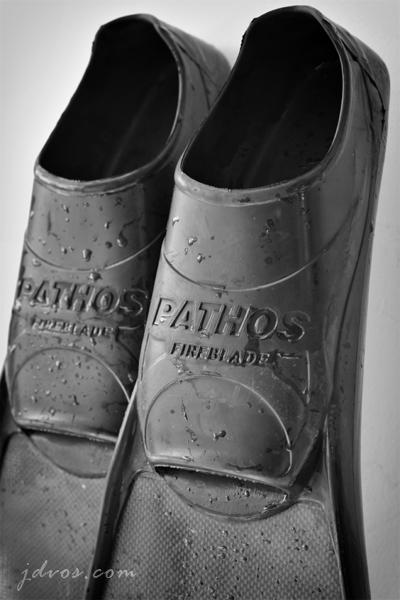
Before purchasing these footpockets I sent an email to a well known online dive store from whom I purchased my Salvi 4One’s, to ask how the Pathos compares to the Salvi footpocket.
The person helping me is a very accomplished Greek spearo and the response I received was the following:
“Hi Jacques
here’s some more info regarding the footpockets.
The Fireblade is made with an angle. I haven’t measure it but I believe it’s 22 degrees. The footpocket is very soft so it would fit any blade from 15 to 26 and more. It is made with performance in mind and is preferred for dives under 30m of depth because it’s lighter. However the comfort is reduced. It’s usable with 3mm socks without any problem. With 5mm socks it’s getting just a bit uncomfortable but nothing to worry about. When I say uncomfortable I mean it compared to other brands. If you get OMER, the Fireblade is much more comfortable due to its softness… Compared to Salvimar though it’s just a bit less comfortable since the Salvi has a better pocket.
Here’s one thing that is very important – the groove on the footpocket is thinner to fit the blade directly. Therefore you have to glue the pocket directly. This means you can use the Fireblade only once! If you can’t change the blade without destroying the pocket!
Regards”
I decided that I would give it a shot and had Linda Paganelli bring me a pair from Greece…
I’m writing this review after six months of full time use of the Pathos footpockets on carbon blades, using them for everything from daily instructing, my own deep dives, freedive photography and videography to safety dives in competitions. Therefore I can truly say I’ve put them through their paces and the review is based on multiple hundreds of dives under different conditions.

1. They are SERIOUSLY Light
This is probably one of the first things which come up in any conversation when discussing these footpockets and the reason it does is because it is so true it’s awesome. The weight compared to other footpockets is so huge in difference that the feather light weight of the Pathos on my Carbon blades makes it feel like I’m holding a sheet of paper (ok, not quite…but it’s really light). A single 42-44 size Pathos Fireblade footpocket weighs an incredible 390 grams! Does this matter…yes! Having a decent blade setup combined with feather light footpockets on deep dives makes a world of difference…like having the thrust of fins while feeling like there is nothing on your feet!
2. They ARE comfortable
In the email sent to me (above) it was said that these footpockets would be less comfortable than the Salvimar 4One’s…I disagree completely!
I do all of my diving in Dahab without socks and this is how I’ve been using my Pathos Fireblades. They are super comfortable and also soft but not so soft as to lose any power. An important point to make is that Salvimar loves to advertise the ‘power band’ over the bridge of the foot on their 4One’s. Incidentally the Pathos Fireblades have exactly the same feature, it’s just not made as obvious. The Salvimar 4One’s have some reinforcement in this area and it is ‘visible’ to the wearer by the ribbed shape banding on the surface of the footpocket (purely aesthetic and great to bring this feature to your attention). Pathos has a similar band of reinforcement over the same area but it is not visible when looking at the footpockets in store (smooth, clean surface), but it is however visible when viewing them underwater. As the rubber gets wet (and discolours) you can clearly see a different colour banding across the bridge of the foot…more importantly you can feel it as a thicker less flexible part over the bridge, even when using your fingers.
3. The most important part…Ribs
When blade manufacturers produces a blade they do so with very particular specifications in the sense that a blade is designed to flex a certain way, bend at a certain point and be able to have a particular ‘return’ (the speed at which the blade snaps to its neutral position after being flexed).
So many people spend hundreds of dollars/Euros on fancy blades and then deprive them of all their awesome features by sticking them into the wrong footpockets. The biggest problem:
The width of the ribs…(the two extensions which mount to the sides of the blade)
Its quite easy to understand, have a look at the comparison between the width of the Pathos Fireblade ribs and the Salvimar 4One ribs:
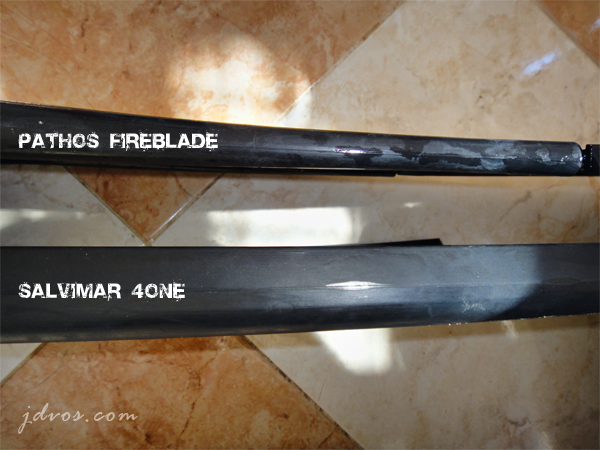
Due to the MUCH thicker ribs on most footpockets (like the Salvimar 4Ones), the blade is unable to flex at the point where they fit into the footpocket with the efficiency they were intended to. This has the biggest effect on softer to medium stiffness blades as you can have the softest blades in the world, but if you stick them in a footpocket with ribs the width of your wrist they just won’t perform the way they should. You end up with the majority of the blade flex occurring at the point where the footpocket ribs end.
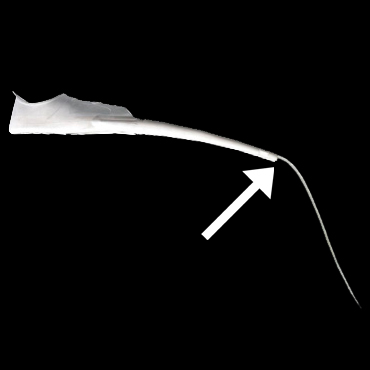
Other footpockets have ribs which are too stiff resulting in poor blade performance…
The Pathos ribs are so narrow (hence the statement in the email which almost sounded like it was a matter of concern) that they allow the blade to function at is optimum specs. I have always been aware of this fact but recently it was proven quite efficiently when someone using a pair of carbon blades similar to mine (I designed the blades so the specs were identical) had them mounted in a pair of OMER footpockets. Trying his fins and comparing it to mine was shocking…even though its exactly the same blades it felt like they were 50% stiffer (due to the much thicker ribs) and diving felt noticeably harder due to a lack of thrust and an increase in weight.
Note the thin ribs compared to the original rubber profile of the blade
Based on this alone I’d buy Pathos Footpockets again and again…
4. To screw or to glue?
This point comes up quite a lot when selecting footpockets, sometimes even becoming the deciding factor. Personally I hate screws…they look crap and most importantly they weaken the blades (a point proven in my previous post).
The rib grooves on the Pathos Fireblade footpockets are so narrow that it is necessary to remove any blade trimming (like rubber profiles) and gluing the footpocket straight to the blade. The upside to this is what was mentioned before, there is less rubber ‘strutting’ to interfere with the performance of the blade but the downside is that once they are glued in, it’s permanent. I have had to remove a pair of Pathos footpockets from Fibreglass fins before and it involves cutting the footpocket to pieces (the blade of course survives), so in that regard the email above was correct. In my opinion it’s worth it…the Pathos Fireblade footpockets are constructed so well that it’s unlikely that they will perish easily so you should get years of (efficient) diving from them. As an instructor I’m in the water every day with mine and there is no sign of wear and tear yet, something my Salvimar 4One’s did not live up to…
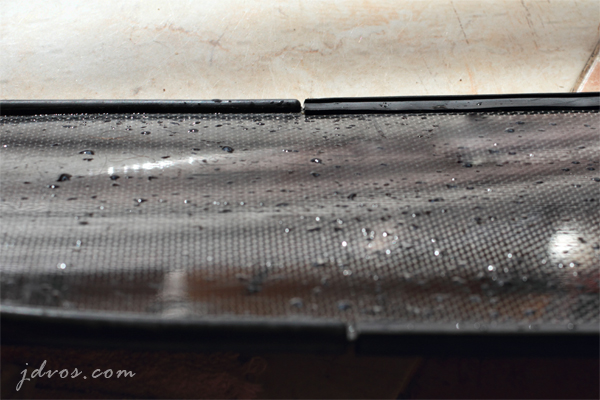
Extremely thin ribs make the Pathos Fireblade very efficient in combination with the right blades
The Bottom Line:
I have no complaints about these blades and I’m unlikely to change brands again…despite the permanent nature of the Pathos in terms of mounting, I doubt I will have any reason to replace my current pair, but when I do I will most definitely go for another pair Pathos Fireblades.
![]()

